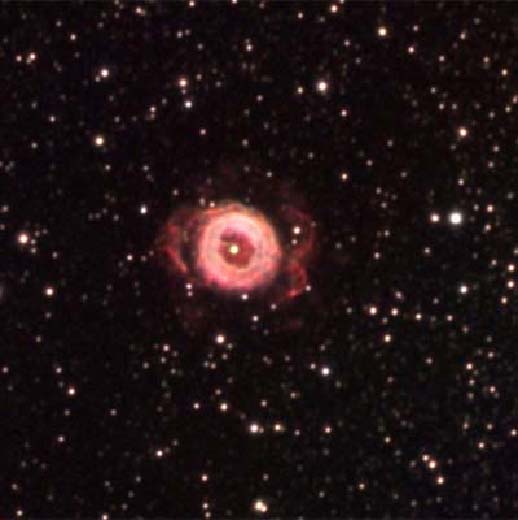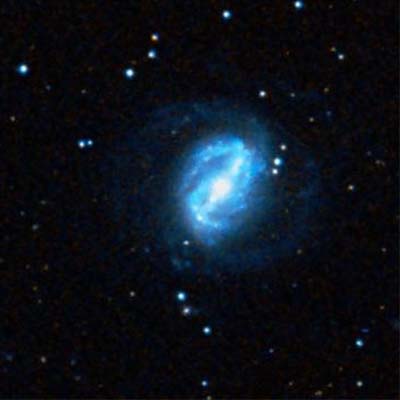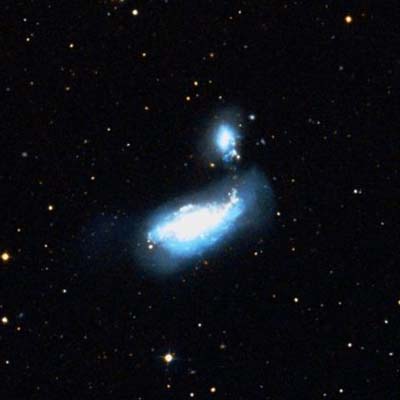OR: June at Deep Sky Ranch II
by Mark Wagner
|
Several observers met at the new home of our friend Kevin Ritschell on June 13, for a night of observing. Present were Jamie Dillon, Peter Natscher, David Cooper, Richard Navarrete and myself. This new site is close to Lake San Antonio, where southern and northern California amateur astronomers have been meeting annually for CalStar, each September or October new moon. Kevin's place is higher elevation, and darker than CalStar. The drive there along the backroads was easy and enjoyable. Below is a shot from of one of the area's less traveled byways, with a view of Pinnacles National Monument in the distance. Its really quite easy to get to these places.
These dark skies are within two and one half hours south of the San Francisco bay area, and provide very good observing for an overnight trip. The travel there and back is part of the enjoyment, as a respite from the crowded cities and bright night skies. This was an easy paced night observing targets we'd visited years ago in smaller telescopes, and spending plenty of time just enjoying the ambience our host provided and seeing friends again. We certainly weren't pushing it. Here are my notes on a few targets Richard and I observed
together in our 18" f/4.5 Obsession Dobsonians. It is always interesting
to see afterward how closely my visual notes match images of the objects. -- Mark Wagner |
|
NGC 5619: Spiral galaxy in Virgo. Magnitude 14, size 2.0'x1.3'. Viewed in 12mm Nagler - NGC 5619 is easy to see but still somewhat dim. 2x1 ratio, about 2.1'x1.1' in size, ne/sw. IC 4244 is also elongated in a nearly perpendicular position angle, smaller and with a brightened core. The UGC 9258 is the dimmest and equidistant away from the IC as the IC is away from the NGC. UGC is smallest and round
NGC 6369: Planetary Nebula "Litle Ghost" in Ophiuchus. Magnitude 13.0, size 1.1'. Distance unknown. Viewed with 7mm Nagler, no filter. Very bright due to its small size, and quite round. Contains a very large and dark annularity for its size. The ring shape is fairly even brightness with one edge slightly darker. Just a small out of focus star in the 20mm Nagler.
IC 4593: Planetary Nebula in Hercules. Magnitude 10.0, size 0.3. Distance unknown. With a 7mm Nagler and NPB narrowband filter. This very small planetary, appering nearly stellar, is given away by its color. It contains a bright central star, with an oval disk that is tight to the star and requires magnification to see easily. Possible dim outer envelope but nothing I can claim as certain, just suspected.
NGC 6217: Barred spiral galaxy in Ursa Minor. Magnitude 11.20, size 3.4'. 67 million light years distant Observed with a 12mm Nagler - described in the Night Sky Observer's Guide as round, but it seems elongated. Or there could be a bright elongated central section crossing a round dimmer galaxy Largish, and obvious, bright core. A 7mm Nagler shows galaxy to look inclined oval with hints of spiral arms. Core is intense and non-stellar at this magnification - slight possibility of an elongation or short bar extending from the core. With a 5mm a knot appears away from the core maybe 2/3rd the distance to the edge of the disk.
N4490: Spiral galaxy with attached companion in Canes Venatici. Magnitude 9.8, size 6.7'x2.1'. Nicknamed The Cocoon Galaxy. Distance unknown. With a 12mm Nagler there are two bright galaxies in close proximity,
at nearly right angles to each other. The larger galaxy is very bright,
elongated with a bright and thick chaotic chore. Clearly a spiral galaxy,
it has a section away form and arcing toward the dimmer of the pair.
This section is longer and larger than that rather stunted but thick
section opposite the larger galaxy's core. The smaller galaxy, NGC 4485
is angled toward NGC 4490, but close to right angle. It too appears
distorted and uneven, shorter and bright. N4490 is about 2x1 in ratio,
N4485 is about a third the size and a comma shape, with the concave
section toward the length of N4490.
N5996: Elongated galaxy with a close companion in Bootes. Magnitude 14.4, size 1.5'x0.8'. Distance unknown. Using a 7mm Nagler, the main galaxy is oddly shaped, elongated but appears as if it is asymmetrical. Very obvious apparently double stellar cores, the galaxy is at close to a right angle from a pair of very close by equal magnitude stars. Opposite the galaxy from the pair of stars is a single dimmer star, and NGC 5994, a much dimmer galaxy is just off it opposite side from the double stars. |






